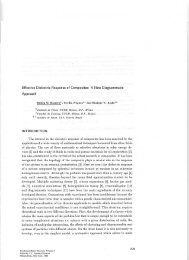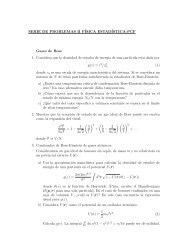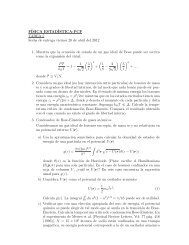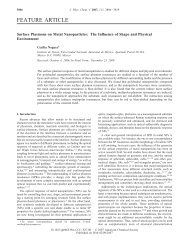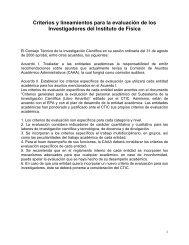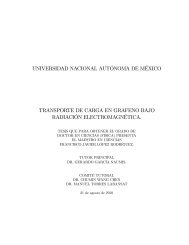Langmuir monolayers of C17, C19, and C21 fatty acids ... - UNAM
Langmuir monolayers of C17, C19, and C21 fatty acids ... - UNAM
Langmuir monolayers of C17, C19, and C21 fatty acids ... - UNAM
You also want an ePaper? Increase the reach of your titles
YUMPU automatically turns print PDFs into web optimized ePapers that Google loves.
7028 J. Chem. Phys., Vol. 110, No. 14, 8 April 1999 S. Ramos <strong>and</strong> R. Castillo<br />
FIG. 10. Several a isotherms <strong>of</strong> the C 21 <strong>fatty</strong> acid temperatures are<br />
indicated in Centigrade scale. They show the main phase transformations<br />
for those temperatures, as well as the location <strong>of</strong> a new phase I. The areaaxis<br />
labels are for the 7.5 °C isotherm; other isotherms are shifted horizontally<br />
proportionally to temperature for clarity.<br />
to another mosaic <strong>of</strong> domains, also with a very low level <strong>of</strong><br />
contrast among domains. However, this transition is quite<br />
clear, <strong>and</strong> BAM images allow to see the needle-shaped domain<br />
characteristics <strong>of</strong> the CS phase. Isotherms show this<br />
transition with a small kink. In the L 2 – L 2 , we also observed<br />
a similar change from a mosaic <strong>of</strong> irregular domains to another<br />
mosaic <strong>of</strong> irregular domains. However, in this case the<br />
change occurs more rapid, <strong>and</strong> the level <strong>of</strong> contrast in L 2 is<br />
lower than in L 2 .<br />
4. Transitions between tilted phases (NN or NNN) to<br />
some intermediate position<br />
As mentioned above, all our observations suggest that<br />
there is a phase I in C 21 , with an intermediate tilt between<br />
NN <strong>and</strong> NNN directions. One phase <strong>of</strong> this kind was observed<br />
in the same relative place in C 20 , by Durbin et al. 13 In<br />
the present work, the phase transitions L 2 – I <strong>and</strong> I – L 2 were<br />
detected in several isotherms as small kinks. Nevertheless,<br />
they are not so clear to be a conclusive evidence. a<br />
isotherms showing these kinks are presented in Fig. 10. The<br />
transition between I – L 2 can be observed easily with the<br />
BAM. An example is shown in Fig. 11. There is no big<br />
change in contrast along the field <strong>of</strong> view during this transition,<br />
although, there is a clear change in the mosaic <strong>of</strong> domains.<br />
In some cases, it is possible to observe how domains<br />
grow.<br />
Our borderline for the L 2 – I transition agrees with experimental<br />
points <strong>of</strong> Lin et al. 14 In the isotherms <strong>of</strong> those<br />
authors, there are some small rounded kinks slightly above<br />
their C – D transition, in the temperature range <strong>of</strong><br />
FIG. 11. Phase transition between I – L 2<br />
phases at T10.9 °C <strong>and</strong> <br />
19.2 mN/m. Defects do not change along the transition, so they can be<br />
used as a guide to the eye to localize domain changes. a I phase slightly<br />
below the transition line, <strong>and</strong> b L 2 phase slightly above the transition line.<br />
7.0– 8.5 °C. That could correspond to the I – L 2 phase transition.<br />
Nevertheless, this is not clear from their isotherms.<br />
They did not make any comment about this feature. Our<br />
observations with the BAM did not allowed us to give a<br />
clear-cut transformation line. This is rather a continuous<br />
transition, where some light gray domains darken slowly becoming<br />
dark gray domains. This goes into the direction <strong>of</strong> a<br />
second-order phase transition. Our observations about the order<br />
<strong>of</strong> the phase transitions do not agree with the work <strong>of</strong><br />
Durbin et al. 13 They classify them in the reverse way, i.e.,<br />
L 2 – I as a first-order <strong>and</strong> I – L 2 as a second-order phase transition.<br />
C. Localized oscillations<br />
In crystalline phases <strong>of</strong> the C 21 monolayer, i.e., L 2 <strong>and</strong><br />
CS , it is possible to observe localized oscillations. These are<br />
localized holes surrounded by Newton rings, which are<br />
blinking, i.e., they appear <strong>and</strong> completely disappear suddenly<br />
in the same place <strong>of</strong> the monolayer. They can be observed<br />
along the monolayer at several parts <strong>of</strong> the field <strong>of</strong> view <strong>of</strong><br />
BAM. In Fig. 12, we present an example <strong>of</strong> these localized<br />
oscillations in four different images, coming from the same<br />
area <strong>of</strong> observation in the monolayer. This images were obtained<br />
from our VCR tape observation records, where the<br />
elapsed time from the first image to the last one is less than<br />
Downloaded 26 Feb 2003 to 132.248.7.15. Redistribution subject to AIP license or copyright, see http://ojps.aip.org/jcpo/jcpcr.jsp




